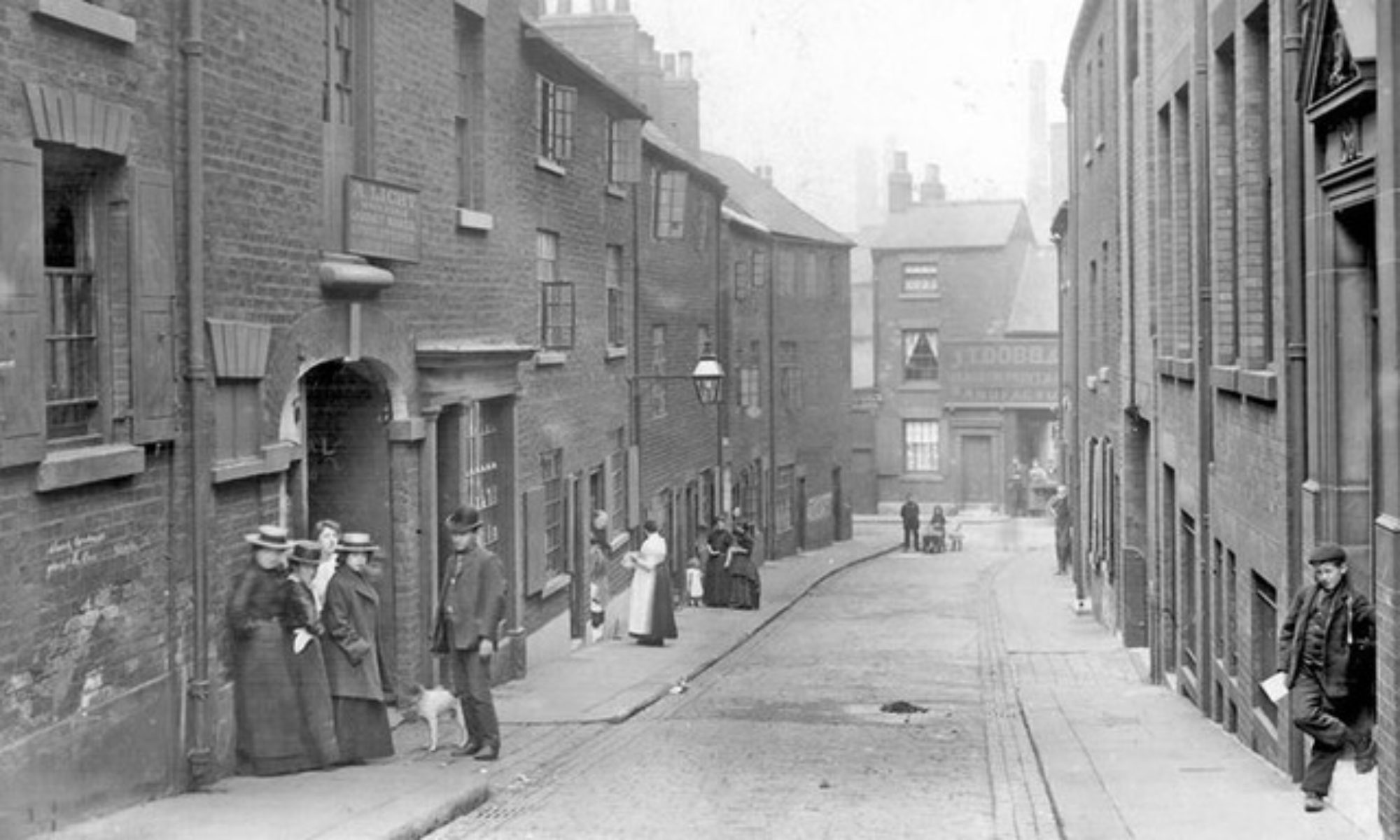NOTE TO READERS: Over these Episodes i have made several references to Eywood Court; Lately Marjorie and i have
been watching the Downton Abbey stories on Netflix and were struck with the similarities to Eywood Court where my
grandfather was once the head gardener. So here is the story in a little depth with comparisons to the Downton Abbey series.
EPISODE 490 EYWOOD COURT compared to DOWNTON ABBEY..(one is real, the other is good historical fiction)
alan skeoch
Dec. 23, 2091
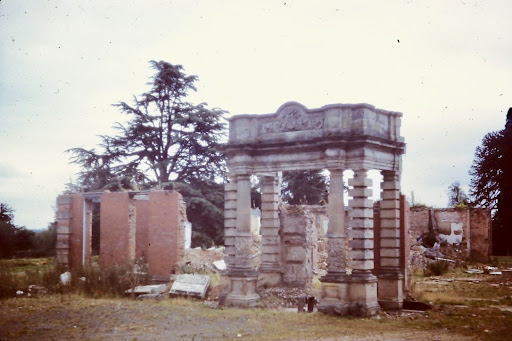
THE RUINS OF EYWOOD COURT (demolished in 1954)

How do I start a story that has more twists and turns than a maze in a British Country House garden?
The story of Eywood is just that. Twisted. Confusing. Heart warming. Profane. Do I start in 1812 with Lord
Oxford going for long walks while Lord Byron is having sex with his wife Lady Lamb…sex over and over for weeks on end…October
and November 1812. Sex can be a big motivator.
No. ” Keep it simple in the beginning Alan or you will lose your audience.” Good advice given to me decades ago
by Doug Koupar who was my producer on CBC Radio. “If you don’t get attention in first few words, you will never
get attention because for most people their attention span is 1 minute…60 seconds.
Test: What got your attention in the first paragraph?
Unfortunately Lord Byron’s many love affairs with other men’s wives was unknown to me when I decided to search
for Eywood Court. A picture of that grand English country house hung in the kitchen of my grandparents farm
in Erin Township, Wellington County, Ontario.
By chance I was wrapping up a job in Ireland. Wednesday September 7, 1960. just completed a
survey job on an ancient mine site on the south coast of Ireland. No doubt my boss Dr. Paterson expected
me to fly back to Canada with our equipment straightaway. I had other plans..
Why would I do that when one of the great mysteries of our family was near at hand. Could I find Eywood?
“Eywood? Did you say Eywood, Alan?”
“yes, Eywood…not Heywood or Haywood…but Eywood.”
“Odd name for an English Country Estate?”
‘“Very odd. Even researchers get it confused.”
“Difficult.”
“Made even more difficult after the huge Eywood mansion had
been demolished….some say the last standing walls were blown
up after all the contents were sold at auction. Tragic.”
NOTE TO READERS: EYWOOD AND DOWNTON ABBEY HAD MANY THINGS IN
COMMON.
ON WED. SEPTEMBER 7, 1960, I DID NOT EVEN KNOW WHAT
THE TERM COUNTRY HOUSE MEANT. ALL I KNEW WAS THAT EYWOOD COURT
EXISTED SOMEHWERE IN HEREFORDSHIRE, ENGLAND. AND I HAD A FEW DAYS
TO SEARCH FOR IT BEFORE FLYING BACK TO CANADA. WAS THIS SEARCH
A WILD GOOSE CHASE?
Irish Diary, Dublin, Ireland, Wed. September 7, 1960
“Arose late and had hell of time to get to the Ferry on time.
Persuaded taxi to scream through the streets of Dublin to make
connection with Irish Daily Mail boat. Caught train to Herefordshire
…travelling blind. May as well get off train in city of Hereford.
But what then.? Where am I going? The platform emptied and I just
stood there. I did have one clue. Polly Griffiths had written to grandma
all her life. She lived with her son Cyril Griffiths on Lower Wooton Farm.
Big deal. Where the hell is that Farm? Then a kind of miracle happened.
One man wakling by noticed my confusion and asked:
“Can I help?”
“Yes, I am looking for Lower Wooton Farm.”
“That would be Cyril Griffiths, I suspect?”
Yes, I know the family…I am their bank manager.?
“Where is the Farm?”
“Some distance from here near Almely and Kington, can
I give you a lift?”
(By pure chance I had found the needle in the haystack…the banker drove
me to Lower Wooton Farm which was hidden away on a country road
a long distance from Hereford.)
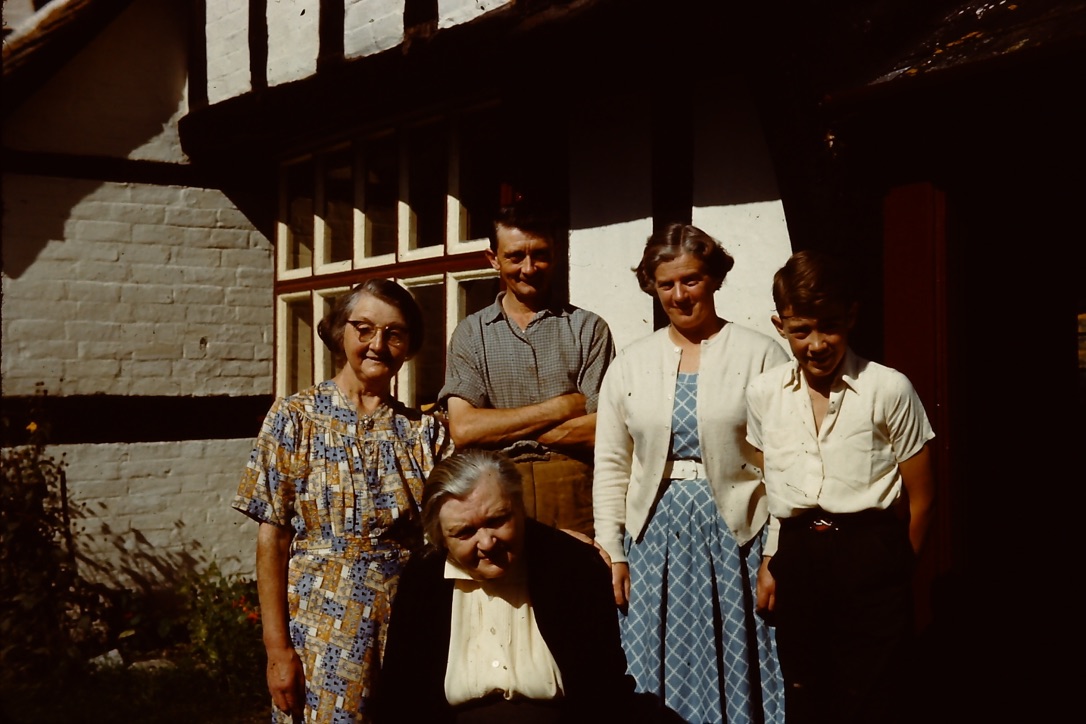
Left to right: Unknown person, Cyril Griffiths, Nancy Griffiths, David Griffiths, with :”aunt Polly” seated at front.

LOWER WOOTON FARM (A designated historical 16th century farm house where the Griffiths lived in 1960)
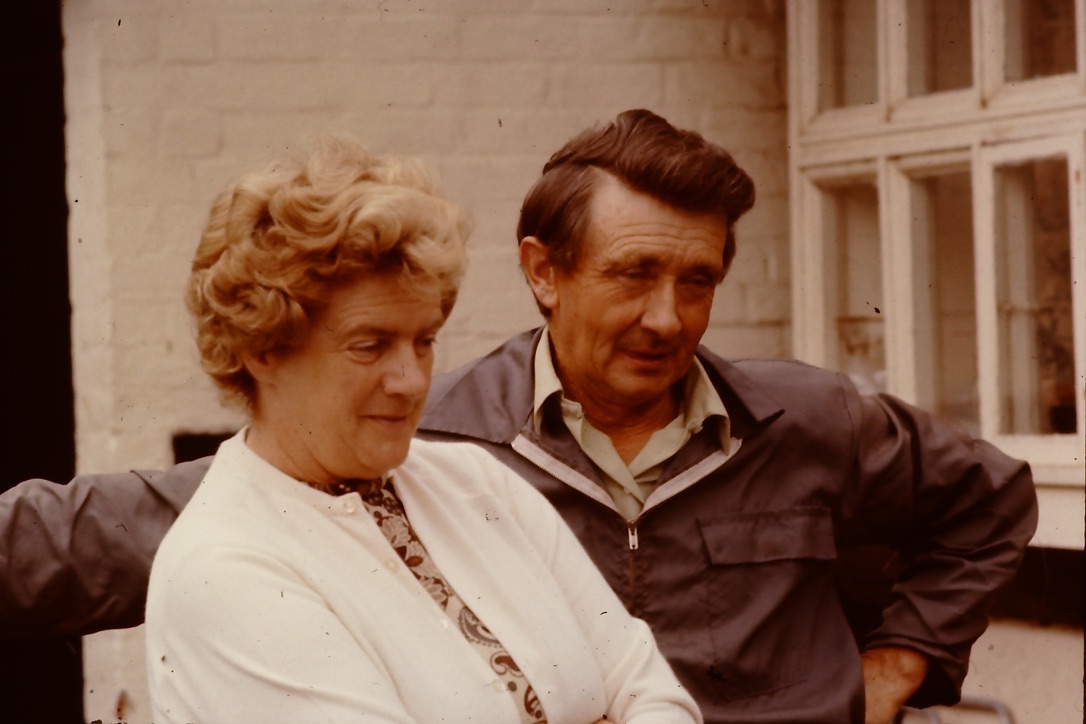
CYRIL AND NANCY GRIFFITHS…tenant farmers on Eywood at Oatcroft Farm
Cyril, Nancy, Polly Griffiths and their son David greeted me with
open arms. They knew me from grandma’s letters. David was
a few years younger than me but we bonded immediately. Nancy
bedded me down in a grand bed in their large 16th century farm
house…a heritage farm designated to be saved.
Thursday, September 8, 1960:
I was first up. What a beautiful sunshiny day? David took me around
the farm and then we helped his father Cyril de-beak turkeys so they
would not peck each other to death. Then we drove to Eardisley a quaint
little 16th century village with ancient houses featuring frames of timbers
and then bricked in and painted white…called black and white village…hard
to describe. Then drove on to an auction in Leominster. Back to Lpwer
Wooton for country farm dinner.
Seemed like a full day but not so as Cyril drove me to Eywood Court
in the evening. I should say the ruins of Eywood Court because the mansion
house had been demolished in 1954 after anything saleable was sold at auction
All that remained standing was the Greek pillared entranceway. Very
sad. Demolitions were happening all over England in the 1950’s and 1960’s. Most owners could not
afford the maintenance and the taxes.
The strangest thing about this visit was that all the other buildings on the
Estate remained untouched. The heart had been removed but the
body remained.
This was underscored when we walked up a shaded laneway…unused
for a long time…to Eywood Garden where Granddad had been head
gardener sixty years ago. Henry Mills bought the walled gardens at the
auction. He had been a young boy working for granddad years back.
Remembered granddad well. “He planted these trees and espaliered the
nectarines in the north wall green house.” We even toured the ‘cottage’
where mom (Elsie Freeman) was born. Called a cottage but it was bigger
than the farm house in Canada. many glass green houses most of which
were derelict. Lots of broken windows.
There was something touching about the way Henry Mills remembered
granddad and grandma…as if they were family. He inferred the same about
Cyril and Nancy Griffiths who were tenant farmers on Eywood before
the auction sale. Kindred spirits. The Griffiths were tenants at Eywood while Granddad Edward
Freeman was an employee in charge of a crew of gardeners. Part of the
large complicated humanity of an English country estate. Exactly the same
as Downton Abbey with one difference. Eywood Court was real. Downton
Abbey is fiction…good, accurate historical fiction.
We have visited the tumbledown ruin of Eywood many times since my 1960 visit.
There is much more to the story. I have struggled with this story. Where should
I start? Deep in the past when Eywood was created? Perhaps a chronology of
the owners of Eywood? Maybe I should extricate the personal connections and
use a third person voice…i.e. drop the use of “I” and replace it with a more dispassionate
voice?
In the end, I felt most comfortable telling the story of Eywood as I experienced the
story. Using the thread that is my personal journey in life to lead readers
deep into a very disturbing yet emancipating event that
had been happening all over England and Scotland from the end of World War I
to that Wednesday evening, September 7, 1960, when I stood among the
bricks and rubble of what was once a grand country mansion. Eywood Court.
The Demolition of a way of life.
This is Part One of that story, Episode 490.
“Give me the numbers!” That demand was made years ago when I had a small role as
co-author with John Ricker and John Saywell creating a text book for Ontario
schools. “Give me the numbers!”, Cut the crap. Get to the kernel of the matter.
I got the numbers for Eywood. Found the needle in the haystack. Found a document
once held by a person at the Eywood auction. A scribe who noted the price Eywood
sold for a public auction.
“Give me the numbers1”
“Eywood sold for 5,400 British pounds serling.”
“What does that number mean?”
“In 1954 the 60 acre centre of the Eywood Estate went to the highest bidder for 5,400 pounds.”
“How much is that in today’s terms”
“Today the British pound is worth #1.73 Canadian.”
“How much is a 1954 British point worth today?
“1 pound in 1954 is worth 33.45 pounds today.”
“Then how much did the Eywood Estate sell for in today’s figures?”
“Give me the numbers!”
“You could buy the estate for $356,400 Canadian dollars.”
“What does that mean?”
“It means the whole heart of the Eywood Estate sold for a pittance…the price of
one of the cheapest houses in Toronto…less than $400,000 dollars.
BUT WHAT DID BUYER GET?

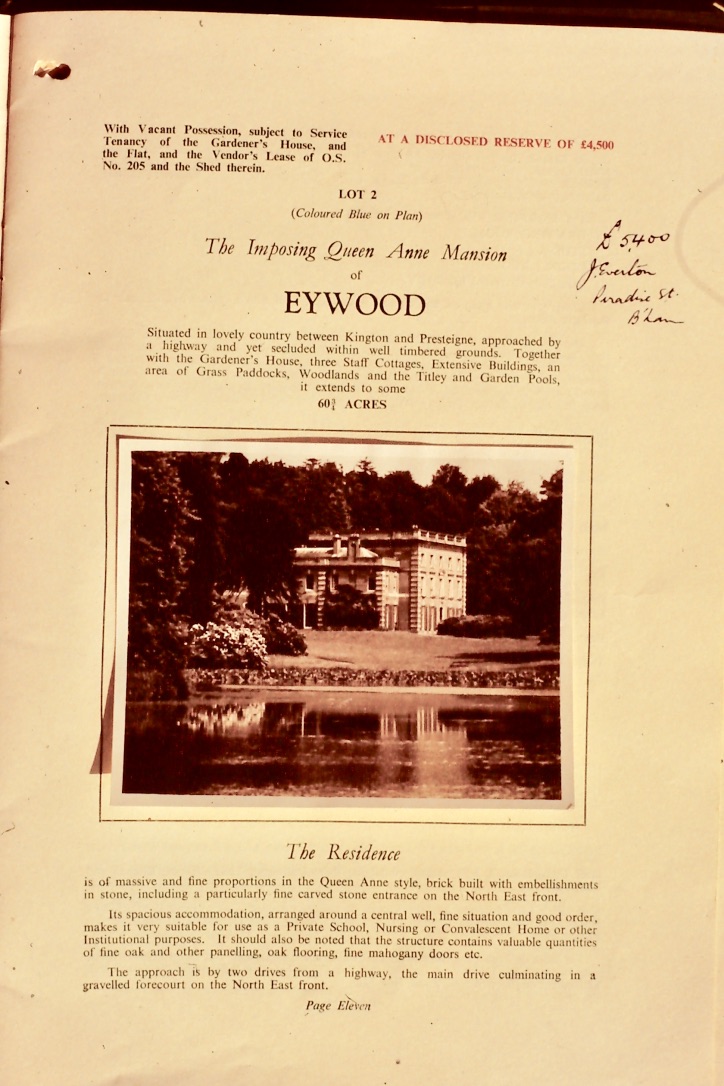
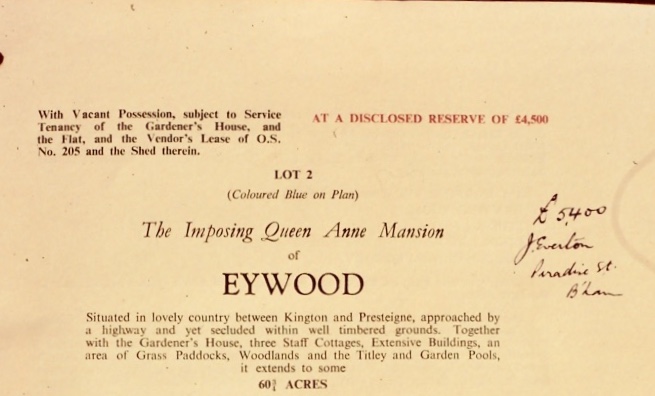
WHAT THE BUYER GOT FOR $356,400 (value of his 5,400 pounds in today’s currency)
1) The huge manor house
2) All the interior fittings, much in mahogany
3) Gardener’ House
4) 3 staff cottages
5) Extensive farm buildings
6) 60 acres of land…the grand park
7) Woodlands
8) Rotodendron gardens
9) Two small lakes, the Titley and Garden Pools
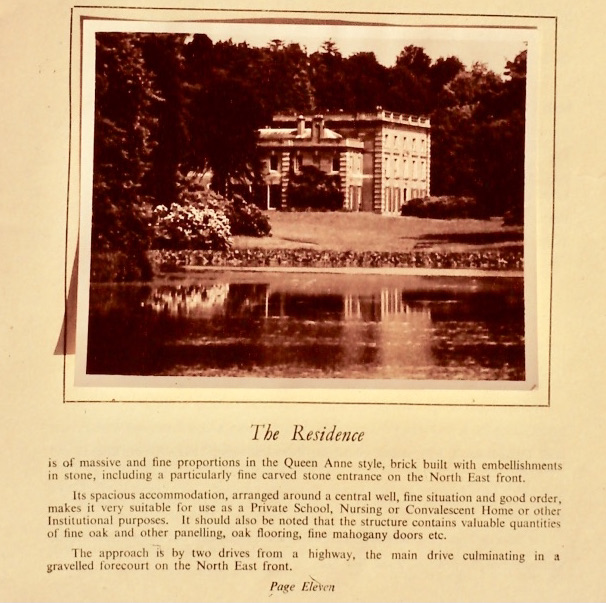
NEXT EPISODE…SEE WHAT THE BUYER GOT FOR MUCH OF THE EYWOOD
ESTATE IS STILL STANDING.
